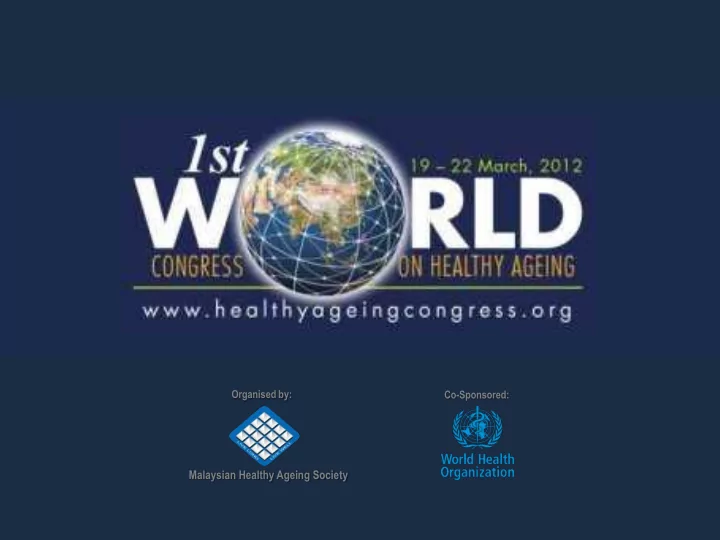

Organised by: Co-Sponsored: Malaysian Healthy Ageing Society
The Effect of Coresidence with an Adult Child on Depressive Symptoms among Older Widowed Women in South Korea: An Instrumental Variables Estimation Authors : Young Kyung Do, Chetna Malhotra Department: Program in Health Services and Systems Research Duke-NUS Graduate Medical School
Background- South Korea • Aging country: – % of elderly > 65 years: from 9% (current) to 38% (in 2050) • Life expectancy (at 65 years) for women is 21 years vs. 16.6 years for men – Older widowed women large and fastest growing group • High rates of depression among widowed and among women • Suicide – a growing problem • Co-residence declining
Objective • To estimate the causal effect of coresidence with an adult child on depressive symptoms among older widowed women in South Korea.
Background: Problems in study design Co- residence Depression with a child
Background: Instrumental variables Co- residence Depression with a child √ X Instrumental Variable Instrumental Variable mimics random assignment of co-residence
Methods: Data and Variables • Data- Korea Longitudinal Study of Ageing • Nationally representative study – two waves • Analytical sample: widowed women >65 years with at least 1 living child – N=2446:1279 (first wave) and 1167 (second wave) • Outcome : Depressive symptoms:10-item CES-D • Main predictor : Co-residence with an adult child
Methods: Statistical analysis • Ordinary least squares (OLS) model; IV two stage least- squares (2SLS) regression • 2 waves treated as repeated cross-sectional surveys, adjusting for clustering at individual level • IVs – • number of sons (continuous variable) • whether eldest child is a daughter (dummy variable)
Table 1: Summary statistics Total Coresiding with Not coresiding n=2,446 an adult child with an adult Variables % n=1,416 % child n=1,030 % Mean Depressive symptom score (0 – 30) 10.00 9.59 10.56 Coresidence with an adult child 57.9 100.0 - Instrumental variables Number of sons 2.07 2.13 1.98 Eldest child is daughter 35.8 37.2 33.8 Those co-residing with a child were older, richer, and more likely to have ADL limitations compared to those not co-residing with a child
Table 2: Ordinary least squares (OLS) and instrumental variable two-stage least squares (IV-2SLS) regression of CES-D score Variables OLS (N=2446) IV-2SLS (N=2446) (95% C.I.) a (95% C.I.) a Coefficient Coefficient Coresidence with an adult − 0.700** (−1.196, −0.204) − 7.749* (−14.092, −1.407) child ** p <0.01, * p <0.05
Discussion and conclusion • Limitations: – Did not measure type and quality of actual or perceived support from adult children – Possible differences may exist by coresidence type – Limited to community-dwelling widows • Methodological contribution to the literature by accounting for endogeneity • Implication: Decreasing rates of coresidence with children is of public health concern among older widowed women in South Korea
Thank you
Korean Longitudinal Study of Ageing • First wave(2006):10,254 adults > 45 years in 6171 households • Second wave (2008): re-interviews with 8,688 respondents from first wave • Analytical sample: widowed women >65 years with at least 1 living child (N=2446, including 1279 (first wave) and 1167 (second wave))
Table 1: Summary statistics Total Coresiding with an Not coresiding with Variables n=2,446 adult child n=1,416 an adult child % % n=1,030 % Mean Depressive symptom score (0 – 30) 10.00 9.59 10.56 Coresidence with an adult child 57.9 100.0 - Instrumental variables Number of sons 2.07 2.13 1.98 Eldest child is daughter 35.8 37.2 33.8 Demographic Mean Age 76.16 77.46 74.37 Education level Elementary school 91.7 91.9 91.6 Middle school 4.3 4.4 4.1 High school 3.1 2.8 3.7 College 0.8 0.9 0.7 Total assets quintile in 1st wave 1 (poorest) 29.7 21.6 40.8 2 30.8 23.2 41.4 3 14.8 17.6 10.9 4 11.5 16.9 4.0 5 (richest) 13.2 20.7 3.0 Residence area Seoul 28.4 28.8 27.9 Other metropolitan area 54.9 52.0 58.9 Province (rural) 16.6 19.1 13.2
Table 1: Summary statistics (contd.) Total Coresiding with Not coresiding with an Variables n=2,446 an adult child adult child % n=1,416 % n=1,030 % Health variables Any ADL/IADL limitations 28.0 34.3 19.4 Self-reported health Very good 0.9 1.1 0.6 Good 12.1 13.2 10.5 Fair 32.3 34.0 29.9 Poor 42.6 40.7 45.2 Very poor 12.2 11.0 13.8 Disease indicator Hypertension 45.1 43.1 48.0 Diabetes 17.7 16.7 19.0 Cancer 2.2 1.6 2.9 Chronic lung disease 3.1 3.3 2.9 Liver disease 0.9 0.8 1.1 Heart disease 8.6 6.4 11.7 Stroke 3.3 4.0 2.4 Arthritis 39.7 38.2 41.7 Injury due to traffic accident 8.2 8.5 7.7 Fall in the past two years 11.9 11.0 13.1 Urinary incontinence 27.6 26.6 28.9 Survey year 2006 52.3 54.7 49.0 2008 47.7 45.3 51.0
• Testing of IV assumptions: • Test of instrument strength • Statistical significance of IV in first-stage regression • Weak identification test • Overidentification test
Table 2: Ordinary least squares (OLS) and instrumental variable two-stage least squares (IV-2SLS) regression of CES-D score Variables OLS (N=2446) IV-2SLS (N=2446) (95% C.I.) a (95% C.I.) a Coefficient Coefficient Coresidence with an adult − 0.700** (−1.196, −0.204) − 7.749* (−14.092, −1.407) child Test of overidentification b , χ 2 (d.f.=1) 0.001 p = 0.9721 Test of endogeneity, F (1, 1420) 7.247 p = 0.0072 ** p <0.01, * p <0.05. a Confidence intervals are based on cluster-robust standard errors. b Hansen-Sargan statistic.
Recommend
More recommend